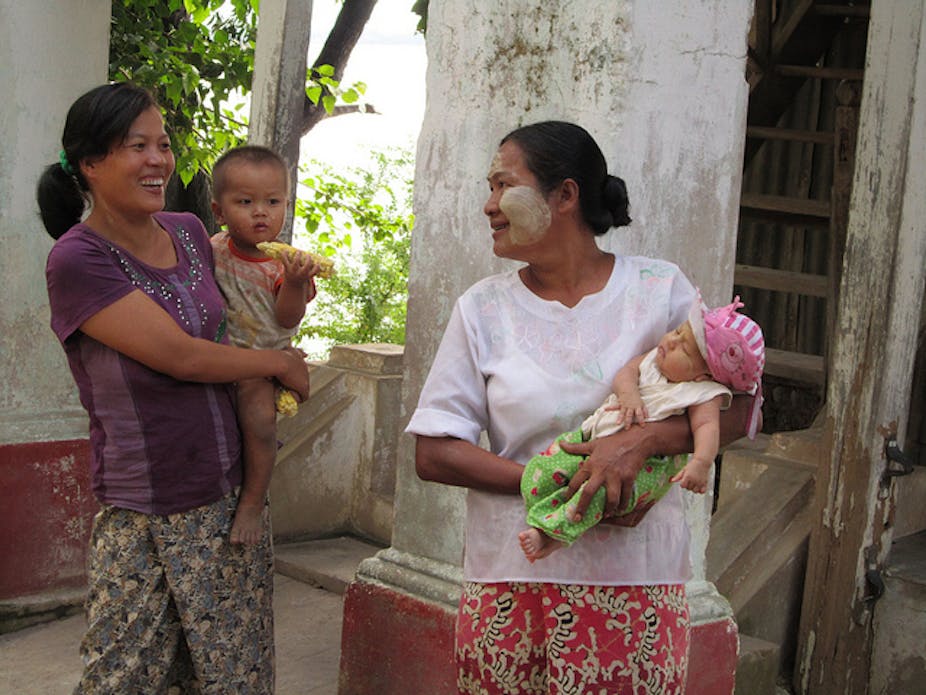As a regional neighbour to Myanmar, the Commonwealth government has recognised Australia has a responsibility – and the capacity – to help alleviate poverty in the developing nation. Australia is also able to support Myanmar to develop an effective maternal and child health-care system.
But while some progress has been made, it is essential that funding commitments and support continue, to ensure Myanmar can reach its targets for improving the health of its most vulnerable citizens.
Women, babies and children
Worldwide, in the five minutes it takes to read this page, three women will lose their lives to complications of pregnancy or childbirth. Sixty others will suffer debilitating injuries and infection due to the same causes. And 70 children will die, nearly 30 of them newborn babies.
Of every 100,000 Australian women who give birth, 8.4 die during childbirth. In neighbouring Myanmar, a country of 52 million people, the rate is 23 times higher – for every 100,000 live births, 200 women die.
In the 20 years to 2010, the maternal death rate has declined by 47%. But while this is an improvement to celebrate, most of these deaths are preventable through proven, cost-effective interventions.
Millennium development goals
In 2000, member states of the United Nations gathered at the Millennium Summit to affirm commitments towards reducing poverty and the worst forms of human deprivation. A total of 189 countries, including Australia and Myanmar, committed to meet the Millennium Development Goals (MDGs) by 2015.
The goals recognise that countless women and children’s lives will be saved through strategies such as family planning, which enables women to delay pregnancy and reduce their risk of death during childbirth; the provision of treatment to HIV-positive women to protect newborn infection; and routine antenatal care, which means complications such as high blood pressure and anaemia can be detected and treated.
Access to skilled birth attendants (particularly midwives) and a health facility that has life-saving drugs can reduce the risk of the mother bleeding or experiencing infection. Saving a mother’s life helps her other children too, because without her they would be between three and ten times more likely to die.
Of the eight MDGs, four are particularly important for maternal and child health: - MDG three, to promote gender equality and empower women - MDG four, to reduce child deaths - MDG five, to improve maternal health - MDG six, to combat HIV/AIDS, malaria and other diseases.
But many countries around the world have made insufficient progress in meeting these goals.

Myanmar’s progress
Myanmar has made some progress towards meeting MDGs four and five. In particular, maternal deaths have reduced from 520 per 100,000 in 1990 to an estimated 200 per 100,000 in 2010.
But progress has not always been uniform. And to meet the MDG five goal of a 75% reduction in maternal mortality, it needs to reduce deaths to 130 per 100,000. A recent review of maternal and child health indicators in Myanmar therefore suggests MDGs four and five are unlikely to be met by 2015.
There has, however, been significant achievements toward MDG six targets to combat HIV/AIDS, malaria and other diseases. The review noted that such achievements are especially notable in that Myanmar has been receiving the lowest level of official development assistance among all of the least-developed countries in Asia.
The review concluded that the Myanmar government needs to increase investment and commitments towards strengthening the health system and to pave the road to universal health coverage.
Improving health infrastructure
Properly educated, regulated and supported midwives can deliver many of the interventions needed to address maternal and newborn health shortfalls. Such systems have been associated with a rapid decline in maternal mortality in Sri Lanka, Malaysia and Cambodia.
However, Myanmar has a scarcity of skilled midwives and quality midwifery education. In fact, Myanmar is one of 57 countries facing what the World Health Organization describes as a severe health workforce crisis, with just 1.3 health workers (doctor, nurse, and midwife) per 1,000 population.
In 2011, the United Nations Population Fund’s State of the World’s Midwifery Report identifies Myanmar as one of 22 countries that needed to double its midwifery workforce.
These factors, along with a lack of health system infrastructure, lead to sub-standard quality of care. And we we know women are reluctant to use maternity services where costs are high and do not meet their needs.
Small steps towards progress
It is commendable that Myanmar’s Ministry of Health has set a target of at least one midwife in each village. But this will take time to roll out. Meanwhile, the country needs to urgently need to scale up midwifery education.
Australia’s Department of Foreign Affairs and Trade (formally as AusAID), has provided four years of funding to support maternal and child health, including access to skilled health professionals and antenatal care, childhood immunisation and funding of programs to assist exclusive breastfeeding. But our commitment shouldn’t end there.
Australia has an excellent health care system for mothers and children and high quality midwifery education programs. It’s important we use our skills and knowledge to assist our neighbours and, as part of the global community, contribute to improving the health of mothers and babies in our region.

